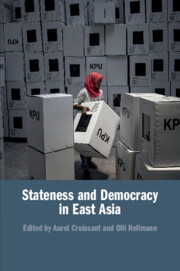Book contents
- Stateness and Democracy in East Asia
- Stateness and Democracy in East Asia
- Copyright page
- Contents
- Figures
- Tables
- Contributors
- Acknowledgements
- 1 Introduction: Rethinking Stateness and Democracy in East Asia
- 2 State-Building and Democratization
- 3 South Korea’s Democracy and the Legacies of the Developmental State
- 4 After Hegemony: State Capacity, the Quality of Democracy and the Legacies of the Party-State in Democratic Taiwan
- 5 Democratization Interrupted: The Parallel State and the Demise of Democracy in Thailand
- 6 Weak State and the Limits of Democratization in Cambodia, 1993–2017
- 7 The Institutional Roots of Defective Democracy in the Philippines
- 8 Stateness and State Capacity in Post-Authoritarian Indonesia: Securing Democracy’s Survival, Entrenching Its Low Quality
- 9 As Good as It Gets? Stateness and Democracy in East Timor
- 10 Stateness and Democracy: Evidence from East Asia and Cross-Regional Comparisons
- Index
- References
1 - Introduction: Rethinking Stateness and Democracy in East Asia
Published online by Cambridge University Press: 13 May 2020
- Stateness and Democracy in East Asia
- Stateness and Democracy in East Asia
- Copyright page
- Contents
- Figures
- Tables
- Contributors
- Acknowledgements
- 1 Introduction: Rethinking Stateness and Democracy in East Asia
- 2 State-Building and Democratization
- 3 South Korea’s Democracy and the Legacies of the Developmental State
- 4 After Hegemony: State Capacity, the Quality of Democracy and the Legacies of the Party-State in Democratic Taiwan
- 5 Democratization Interrupted: The Parallel State and the Demise of Democracy in Thailand
- 6 Weak State and the Limits of Democratization in Cambodia, 1993–2017
- 7 The Institutional Roots of Defective Democracy in the Philippines
- 8 Stateness and State Capacity in Post-Authoritarian Indonesia: Securing Democracy’s Survival, Entrenching Its Low Quality
- 9 As Good as It Gets? Stateness and Democracy in East Timor
- 10 Stateness and Democracy: Evidence from East Asia and Cross-Regional Comparisons
- Index
- References
Summary
The introductory chapter performs four key functions. First, it reviews the relevant literature on the relationship between stateness and the quality of democracy and sets out the guiding questions for the country chapters. Second, the editors define the key terms of the volume – state, stateness and democracy – and break them down into their individual components. Third, based on arguments found in the wider democratization and state-building literature, the editors theorize the causal mechanisms that may connect stateness and democracy. Fourth, the chapter develops the volume’s key argument on the relationship between stateness and the quality of democracy in East Asia more generally. The argument places particular focus on the relationship between the state and particularistic networks and on the disbritution of power between particularistic network. The chances of democratic consolidation are greatest in new democracies where the state has a strong capacity to fend off particularistic demands but political systems characterized by lower levels of state autonomy can develop into electoral democracies, depending on the systemic properties of particularistic networks. Moreover, stateness does not exert a linear effect on the quality of democracy.
Keywords
- Type
- Chapter
- Information
- Stateness and Democracy in East Asia , pp. 1 - 24Publisher: Cambridge University PressPrint publication year: 2020
References
- 2
- Cited by

